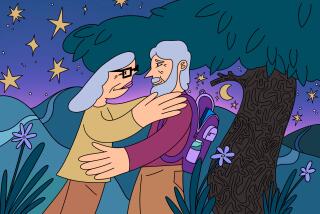Zooming In on Life : THE FLIGHT OF ANDY BURNS, <i> By Alice Mattison (William Morrow: $18; 256 pp.)</i>
- Share via
A teen-aged boy in “Go, Mercy,” one quietly ominous story in this outstanding array, is intrigued by a problem posed in his high school’s Family Life Unit. “If you have two people,” he tells his parents, “there are three possible groupings. . . . One person alone, the other person alone or the two of them together. . . . Now with three people, there are seven possible combinations. . . .” And so on.
“So what?” asks his taciturn, depressed father.
“It’s why family life is complicated,” the eager boy explains. “But what I want to know is. . . . What’s the formula?”
It’s a good emblem for Alice Mattison’s turn of mind. Her subject is the subtle transactions and reactions among family members, friends, lovers, would-be and ex-lovers, which she experiments with like a chemist keenly tracking a crucial discovery. Happily, there is no formula in her fictional world of middle-class, young and not-so-young people, many of them living in or near the author’s home territory of New Haven, Conn.
In every sense, Mattison’s stories stay close to home. They’re sharply focused on the momentous, if hushed, dramas of private life in minutely detailed domestic scenes, where each gesture or tossed-off remark is magnified and laden with consequence, producing an immense ripple effect.
Mattison (author of an earlier collection, “Great Wits,” and a novel, “Field of Stars”) is really more alchemist than chemist; much of the time, she manages to convert everyday dross into pure gold on the page. Rarely has so much been made of so little: A mother’s anxiety over her 5-year-old’s first library card reveals a barely invisible but deep chasm in her marriage. In his fumbling eagerness to comfort his cousin over the loss of a child, a man spills hot coffee in her lap, a sign of his powerlessness and her vulnerability to small as well as great misfortune. And a lonely nurse, who finds her lover “alarmingly . . . powerful and majestic,” is stirred with joyous confidence when he changes a fuse in the basement, announcing, “Let there be light!”
The book’s title comes from an offhand anecdote. Years ago, one character recalls, a schoolmate claimed that on a wet, blustery day, a gust of wind raised him up to carry him through the air, setting him down “right on his route.” Mattison’s characters are all going through a patch of turbulent weather and could use a lift. Mostly women, and often entangled with unworthy or unsuitable men, they’re not in deep trouble, but the commonplace kind that blows through every life: grief in love, vague discontent in marriage, a sense of aimlessness, helplessness in the face of others’ suffering.
Now and then a character in these unnervingly life-like stories is indeed borne aloft by a lucky shift in inner weather and set on the right route. But usually they just grow a trifle wiser. In “The Giraffes,” a book illustrator, badly used by one of the casually malevolent men who recur throughout the book under various names, finds a wry, difficult model of acceptance in the sight of a giraffe at the zoo: “It seemed to me that he thought about everything, everything that was or could be, but did not wish for it.”
Several stories are set in a prison where the visiting heroine runs a poetry workshop. While she attempts ordinary friendliness, she’s invariably left feeling awkward and impotent, worlds apart. The prison pieces are marred by being as inconclusive as life itself--a dubious tactic for fiction. Still, the feel of prison life is pointedly rendered, and the closing lines of “Whom Did You Kill?” embody the distance between inside and out: “Then the outer electronic door slides open, and the three of them step into the waiting room and outside, where they suddenly remember what season it is--spring--and what kind of weather they are having.”
The consciousness propelling “The Flight of Andy Burns” is subdued, watchful, tolerant and sly, sneaking up to deliver lightning bolts of jarring insight. While rowing on a sunny lake, a divorced mother learns of her ex-husband’s plans to remarry. “For a moment, I felt as if I were going to be cold for the rest of my life.” A young married woman describes her feeling for a lawyer in her office: “It wasn’t sexual. . . . I’m not looking for someone. But there’s that good middle category: men you don’t stay up nights thinking about but who seem more definitely placed before your eyes than most men, as if they’re in bold type.”
The quiet tone is deceptive. Mattison is risking drabness for the sake of the sudden bold strokes that illuminate hidden dynamics. Through an evening of nonchalant chatter, the family in “Go, Mercy” is shown to be on the brink of disaster, though only one of the three children knows it yet.
“Raymond and Leona,” the gem of the collection, coolly sketches a footloose, detached generation. Three old college friends are reunited when one of them gets married. Sneaking off like the scornful adolescents they once were, they peer at the festivities through curtains, the bride herself an ironic outsider. “It’s a nice wedding,” one of her friends remarks. “All these relatives--it’s like you called up central casting and said, ‘Send me a wedding.’ ”
Mattison is at her best in the longer, more elaborate pieces, where she gives history and heft to floundering spirits hunting up arbitrary lives. The danger of her method, in too short a space, is a sense of attenuation. What is never attenuated is the author’s painfully precise intelligence. Tolerantly, with mercy, she records what season we are living through, and what the weather is like.
More to Read
Sign up for our Book Club newsletter
Get the latest news, events and more from the Los Angeles Times Book Club, and help us get L.A. reading and talking.
You may occasionally receive promotional content from the Los Angeles Times.






